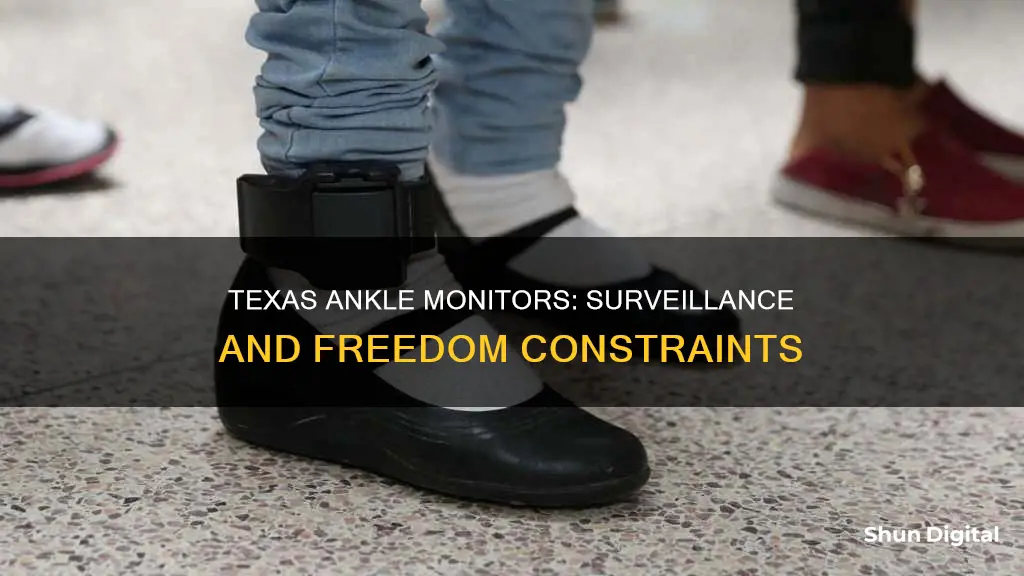
In Texas, ankle monitors are used as an alternative to incarceration for eligible offenders. The two types of ankle monitor technology used by the Texas Parole Division are Global Positioning System (GPS) technology and Radio Frequency (RF) technology. On average, 2,900 offenders are monitored with GPS technology, while 1,800 are monitored with RF technology. Offenders are usually required to pay for the cost of the monitor, which ranges from $5 to $25 per day. Ankle monitors are typically used for house arrest, alcohol monitoring, or for those on bail pending a trial. However, in Texas, high schools have also implemented ankle monitors for truant students.
| Characteristics | Values |
|---|---|
| Who has to wear an ankle monitor? | Offenders with Special Condition Super-Intensive Supervision Program (SISP), sex offenders, people awaiting trial, people on parole, people released on bail, people on house arrest, people on probation, people on bond, people on community service, people in treatment or rehabilitation, people with a history of reoffending, people who have violated bail or parole terms, people convicted of DUI or DWI, people convicted of domestic violence, people awaiting immigration proceedings, people who are vulnerable to abuse in prison, people who are physically ill or incapacitated, people who are juvenile offenders, first-time offenders, people who don't have a long history of offenses, people with a secure and stable job |
| Type of technology | Global Positioning System (GPS), Radio Frequency (RF) |
| Average number of offenders monitored with GPS technology | 2,900 |
| Average number of offenders monitored with RF technology | 1,800 |
| GPS monitoring company requirements | Must have correct and accurate cell and home phone numbers |
| Charging requirements | Must be charged for 1 hour per day, charger must be removed from the wall after charging |
| Cost | $5 to $25 per day |
| Tampering with ankle monitor | A crime, considered a third-degree or state-jail felony |
What You'll Learn

Who has to wear an ankle monitor in Texas?
In Texas, ankle monitors are used as an alternative to incarceration for eligible offenders. The state uses two types of technology to electronically monitor offenders: Global Positioning System (GPS) technology and Radio Frequency (RF).
GPS technology is used to monitor all offenders with Special Condition Super-Intensive Supervision Program (SISP) and all sex offenders with Special Condition Electronic Monitoring (EM). This technology allows authorities to track the movements of high-risk offenders and monitor their compliance with a pre-approved travel schedule. On average, 2,900 offenders are monitored daily using GPS technology.
RF technology, on the other hand, is primarily used to monitor an offender's compliance with a pre-approved curfew schedule. This technology is used to monitor approximately 1,800 offenders.
Offenders who are eligible for ankle monitoring include those who:
- Are juvenile offenders
- Have committed non-violent crimes
- Are first-time offenders
- Do not have a long history of offenses
- Have a secure and stable job
- Are vulnerable to abuse in prison
- Are physically ill or incapacitated
Additionally, ankle monitors are sometimes used for defendants awaiting trial, provided they meet certain conditions set by the court. These conditions may include sticking to a specific area, avoiding certain people, or adhering to a curfew.
In Texas, there have been instances where high schools have used ankle monitors on truant students, which has been a subject of debate.
It is important to note that tampering with or disabling an ankle monitor in Texas can result in harsh penalties, including criminal charges.
LCD TVs: The Pros and Cons as PC Monitors
You may want to see also

How much do ankle monitors cost?
The cost of an ankle monitor varies depending on location, the type of device, and whether the wearer is serving a sentence or on bond. In Texas, ankle monitors are used as an alternative to the cash bail system, which requires people to deposit a large sum of money for their pre-trial release from jail. While ankle monitors are intended to be a more affordable option for people charged with low-level and nonviolent offenses, the wearer typically has to cover the cost of the device.
In general, there is a one-time setup fee for the device, which ranges from $50 to $200. Following this, there is usually a daily usage fee, typically between $5 and $20 per day. This means that the monthly cost of an ankle monitor can be anywhere from $150 to $600 or more. For example, in San Francisco, monthly costs can reach about $1,000. In addition, some states may charge a monthly fee that goes to the probation company monitoring the device, which can be around $30 to $60 per month.
For those who cannot afford the cost of an ankle monitor, there may be payment plans or sliding scales based on income. However, if the wearer falls behind on payments, they may face legal consequences, such as being sent back to jail.
It is important to note that the costs outlined above are specific to the state of Texas and may vary in other locations.
Ring Alarm Monitoring: Receipt Location and Access
You may want to see also

What are the rules for wearing an ankle monitor?
In Texas, ankle monitors are used as an alternative to pre-trial detention or as a condition of probation or parole. The rules for wearing an ankle monitor vary depending on the individual's situation and criminal history. However, some general rules and guidelines are as follows:
- Ankle monitors are typically used for individuals who are considered a danger to the community or a flight risk.
- The device is used to ensure the wearer stays within a certain radius of their home and adheres to a pre-approved travel schedule or curfew.
- The wearer may be required to regularly check in with their probation or parole officer.
- Ankle monitors can detect and track the wearer's alcohol consumption by testing their sweat. This information is then relayed to the relevant authorities, and the wearer may face penalties or jail time if they violate the terms of their monitoring.
- The wearer is usually responsible for paying the cost of the monitor, as well as daily use fees. These fees can vary depending on the wearer's income and ability to pay.
- Ankle monitors are waterproof, but the signal may be weaker or blocked when submerged in water, which can lead to issues with the probation officer.
- In Texas, ankle monitors are not just used for adults. High schools are putting ankle monitors on truant students.
While these are some general rules and guidelines, the specific conditions for wearing an ankle monitor in Texas will be set by the court and may vary depending on the individual case.
Removing Monitor Arms: A Step-by-Step Guide from Your Desk
You may want to see also

What happens if you violate the terms of your ankle monitor?
Ankle monitors are often used as an alternative to pre-trial detention or as a condition of probation. They are also used to ensure that the wearer does not get into more trouble and does not cause harm to others. If you violate the terms of your ankle monitor, you may face additional penalties, including jail time.
In Texas, interfering with the functions of an ankle monitor or removing it is a criminal offence and a violation of your probation or parole. As of 2023, tampering with an ankle monitor is a separate felony offence. If convicted, you could face more than a year in prison.
If you violate the terms of your ankle monitor, you will also need to deal with violating your parole, probation, or pretrial supervision. This could result in you being sent to jail or back to prison for violating the conditions of your release or probation.
However, there are possible defences to tampering with an ankle monitor. For example, a lawyer could argue that your device glitched, causing it to go offline or misreport your location. Another defence could be that any damage to the device was accidental or necessary, such as in the case of a medical emergency.
Removing Adobe Genuine Monitor Service: A Step-by-Step Guide
You may want to see also

How do ankle monitors work?
Ankle monitors, also known as ankle bracelets or electronic monitoring devices, are used by law enforcement to track the movements of certain individuals. These devices are often used for offenders on probation, parole, or house arrest. They are attached to the individual's ankle and send signals that indicate the person's location and movements.
Ankle monitors utilise GPS (Global Positioning System) and RF (Radio Frequency) technologies to monitor a person's whereabouts. They transmit location data to monitoring centres, allowing authorities to ensure adherence to specified boundaries and conditions.
There are two main types of ankle monitors: GPS ankle monitors and RF ankle monitors. GPS ankle monitors use a network of satellites orbiting the Earth to pinpoint their exact location, providing authorities with real-time data on the individual's movements. On the other hand, RF ankle monitors communicate with a receiver installed in the individual's home. If the individual moves outside a certain range, the receiver sends an alert to the authorities. This technology ensures monitoring even in locations where GPS signals may be weaker or obstructed.
In addition to tracking location, ankle monitors have several other features. They are equipped with tamper detection mechanisms, sending an alert to the monitoring centre if someone attempts to remove or tamper with the device. Authorities can also set up exclusion zones, areas where the individual is not allowed to go, and inclusion zones, areas where the individual must remain during specific times. Most ankle monitors must be charged daily, and a low-battery alert is sent to authorities if the battery level drops too low.
While ankle monitors offer a cost-effective and practical solution for law enforcement to ensure compliance with legal restrictions, they also come with certain restrictions and limitations. For RF ankle monitors, there is a limited range, and individuals cannot go beyond a certain distance from the receiver installed in their home. Additionally, daily charging is necessary to prevent low-battery alerts. Some individuals may also find the device uncomfortable or stigmatising.
Ankle monitors are often seen as a humane alternative to jail, allowing individuals to pay their debt to society while providing for their families. However, the technology behind ankle monitors has been criticised as faulty and imprecise, negatively impacting the lives of those it is meant to help. The cost associated with ankle monitors can also be a significant burden, with individuals or their families having to pay daily monitoring fees, installation fees, and other charges.
Hooking Up Sega Genesis Classic to a Signage Monitor
You may want to see also
Frequently asked questions
In Texas, ankle monitors are used for those on house arrest, alcohol monitoring, or bail pending a trial. They are also used for high school students with a history of truancy.
Ankle monitors are used as an alternative to jail time. They allow inmates to continue having jobs and relationships. They are also a way to ensure that someone on bail appears for their day in court.
Those wearing ankle monitors must adhere to specific rules and regulations. This includes sticking to a specific area, avoiding certain people, adhering to a curfew, and sometimes refraining from drinking alcohol.
If someone violates the terms of their ankle monitor, they may be subject to additional penalties, including jail time.
The cost of an ankle monitor can range from $5 to $25 per day. The wearer usually has to pay for the cost of the monitor and a daily use fee.







